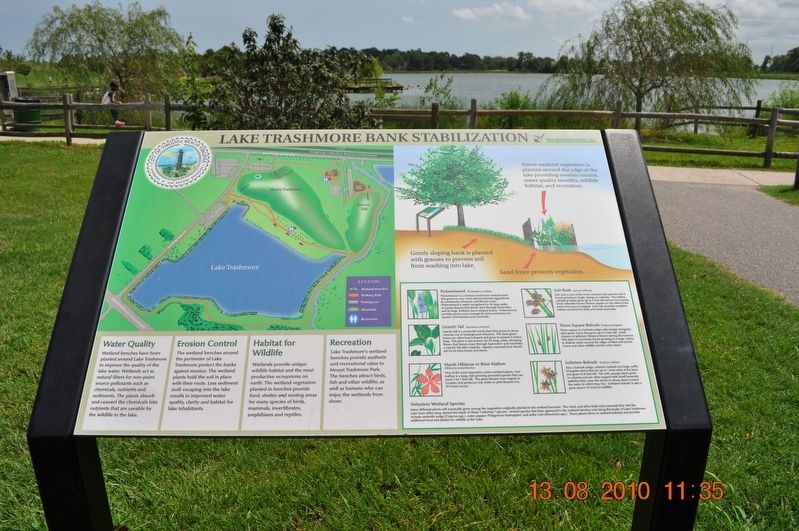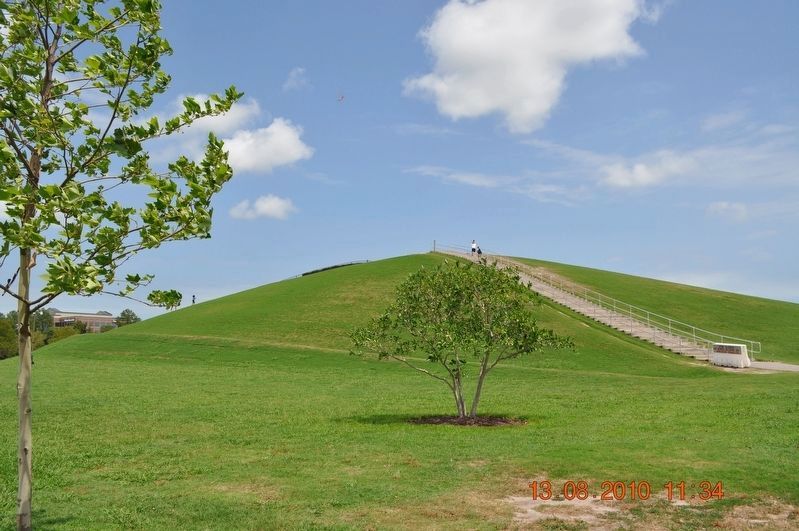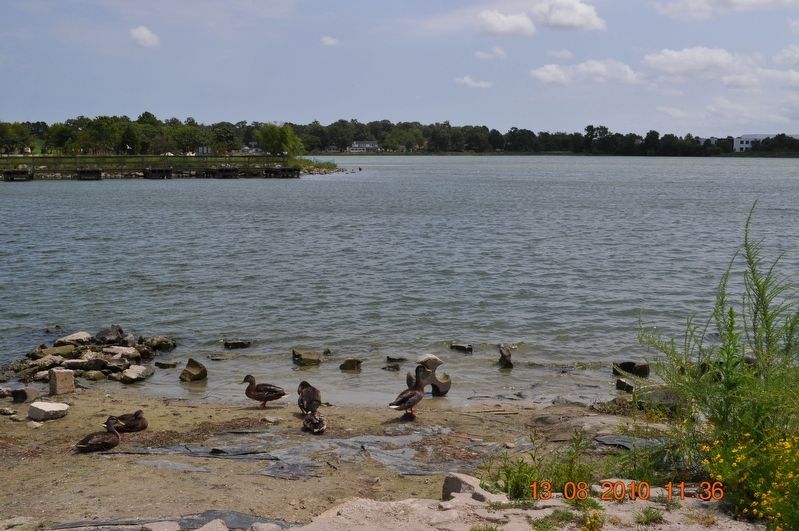Kempsville in Virginia Beach, Virginia — The American South (Mid-Atlantic)
Lake Trashmore Bank Stabilization
Gently sloping bank is planted with grasses to prevent soil from washing into the lake.
Sand fence protects vegetation.
Pickerelweed Pontederia cordata
Pickerelweed is a common freshwater wetland plant that grows to over 3 feet tall and spreads aggressively by underwater rhizomes and fibrous roots. Pickerelweed is easily recognized for its large spike of purple flowers that bloom June through November, and its large, leathery, lance-shaped leaves. Pickerelweed provides great cover amongst its stems and leaves for aquatic invertebrate and mammals.
Lizard's Tail Saururus cernuus
Lizard's tail is perennial marsh plant that grows in dense colonies out of underground rhizomes. The dark-green leaves are often heart-shaped and grow to around 5 inches long. This plant is also known for it's long, white, drooping flower that blooms June through September and resembles a Lizard's Tail after maturity. Aquatic mammals love lizard's tail for its tasty leaves and stems.
Marsh Hibiscus or Rose Mallow
Hibiscus moscheutos
One of the most impressive native wetland plants, rose mallow is a large, fast-growing perennial species that can reach 5 to 7 feet tall. The plant blooms from August to October and produces red, white, or pink flowers 6 to 10 inches across.
Soft Rush Juncus effusus
Soft rush is one of the most common rush species and is found growing in single clumps or colonies. The hollow, cylindrical stems grows up to 4 feet tall and are very pointy. Small yellowish-brown flowers appear on the sides of the stems from June to August. Soft rush provides excellent habitat and food for birds and small mammals.
Three-Square Bulrush Scirpus pungens
Three-Square is a bulrush sedge with sharply triangular, dark-green stems that grow up to 3 feet tall. Small clusters of spikelets (flowers) bloom during the summer. This plant is commonly found growing as a large colony in shallow water around the edges of lakes and ponds. Geese and other wildlife eat the entire plant.
Softstem Bulrush Scirpus validus
Also a bulrush sedge, softstem bulrush has large, softly triangular stems that are up to 1 inch wide at the bas and grow to 8 feet tall. The soft, spongy stems grow in colonies and are often topped with small brownish spikelets that cause the stems to droop down toward the water in which they live. Softstem bulrush is also a great source of food for wildlife.
Volunteer Wetlands Species
Many different plants will eventually grow among the vegetation originally planted in the wetland benches. The wind, and often birds and mammals that visit the Lake from miles away, spread the seeds of these "volunteers" species. Several species that have appeared in the wetlands benches and along the banks of Lake Trashmore include umbrella sedge (Cyperus spp.), water paper (Polygonum hydropiper), and spike rush (Eleocharis spp.). These plants thrive in wetland habitats and provide additional food and shelter for wildlife at the Lake.
Water Quality
Wetlands benches have been planted around Lake Trashmore to improve the quality of the lake water. Wetlands act as natural filters for non-point source pollutants such as chemicals, nutrients and sediments. The plants absorb and convert the chemicals into nutrients that are useable by the wildlife in the lake.
Erosion Control
The wetland benches around the perimeter of Lake Trashmore protect the banks against erosion. The wetland plants hold the soil in place with their roots. Less sediment (soil) escaping into the lake results in improved water quality, clarity and habitat for lake inhabitants.
Habitat for Wildlife
Wetlands provide unique wildlife habitat and the most productive ecosystems on earth. The wetland vegetation planted in benches provide food, shelter and nesting areas for may species of birds, mammals, invertebrates, amphibians and reptiles.
Recreation
Lake Trashmore's wetland benches provide aesthetic and recreational value to Mount Trashmore Park. The benches attract birds, fish and other wildlife, as well as humans who can enjoy the wetlands from shore.
Erected by City of Virginia Beach.
Topics. This historical marker is listed in these topic lists: Environment • Horticulture & Forestry • Man-Made Features.
Location. 36° 49.827′ N, 76° 7.415′ W. Marker is in Virginia Beach, Virginia. It is in Kempsville. Marker can be reached from Edwin Drive south of South Boulevard, on the left when traveling south. Marker is located inside Mt Trashmore Park. Touch for map. Marker is at or near this postal address: 310 Edwin Drive, Virginia Beach VA 23452, United States of America. Touch for directions.
Other nearby markers. At least 8 other markers are within 2 miles of this marker, measured as the crow flies. Seal of the City of Virginia Beach (about 600 feet away, measured in a direct line); History of Thalia / Aunt Penny's Park (approx. 0.9 miles away); Camp Ashby (approx. 0.9 miles away); Filipino American Sea Service Veterans (approx. 1.4 miles away); Filipino American Veterans of Hampton Roads (approx. 1.4 miles away); Filipinos in the U.S. Navy (approx. 1.4 miles away); The Pembroke Manor House (approx. 1.6 miles away); Skirmish at Kemp’s Landing (approx. 2.1 miles away). Touch for a list and map of all markers in Virginia Beach.
Credits. This page was last revised on February 1, 2023. It was originally submitted on August 2, 2017, by Sandra Hughes Tidwell of Killen, Alabama, USA. This page has been viewed 289 times since then and 25 times this year. Photos: 1, 2, 3. submitted on August 2, 2017, by Sandra Hughes Tidwell of Killen, Alabama, USA. • Bernard Fisher was the editor who published this page.


